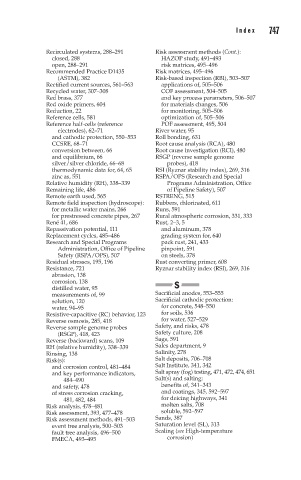Page 797 - Corrosion Engineering Principles and Practice
P. 797
746 I n d e x I n d e x 747
Recirculated systems, 288–291 Risk assessment methods (Cont.):
closed, 288 HAZOP study, 491–493
open, 288–291 risk matrices, 495–496
Recommended Practice D1435 Risk matrices, 495–496
(ASTM), 382 Risk-based inspection (RBI), 503–507
Rectified current sources, 561–563 applications of, 505–506
Recycled water, 307–308 COF assessment, 504–505
Red brass, 377 and key process parameters, 506–507
Red oxide primers, 604 for materials changes, 506
Reduction, 22 for monitoring, 505–506
Reference cells, 581 optimization of, 505–506
Reference half-cells (reference POF assessment, 495, 504
electrodes), 62–71 River water, 95
and cathodic protection, 550–553 Roll bonding, 631
CCSRE, 68–71 Root cause analysis (RCA), 480
conversion between, 66 Root cause investigation (RCI), 480
and equilibrium, 66 RSGP (reverse sample genome
silver/silver chloride, 66–68 probes), 418
thermodynamic data for, 64, 65 RSI (Ryznar stability index), 269, 316
zinc as, 551 RSPA/OPS (Research and Special
Relative humidity (RH), 338–339 Programs Administration, Office
Remaining life, 486 of Pipeline Safety), 507
Remote earth used, 565 RSTRENG, 515
Remote field inspection (hydroscope): Rubbers, chlorinated, 611
for metallic water mains, 266 Runs, 591
for prestressed concrete pipes, 267 Rural atmospheric corrosion, 331, 333
René 41, 686 Rust, 2–3, 5
Repassivation potential, 111 and aluminum, 378
Replacement cycles, 485–486 grading system for, 640
Research and Special Programs pack rust, 241, 433
Administration, Office of Pipeline pinpoint, 591
Safety (RSPA/OPS), 507 on steels, 378
Residual stresses, 195, 196 Rust converting primer, 608
Resistance, 721 Ryznar stability index (RSI), 269, 316
abrasion, 138
corrosion, 138 S
distilled water, 95
measurements of, 99 Sacrificial anodes, 553–555
solution, 120 Sacrificial cathodic protection:
water, 94–95 for concrete, 548–550
Resistive-capacitive (RC) behavior, 123 for soils, 536
Reverse osmosis, 285, 418 for water, 527–529
Reverse sample genome probes Safety, and risks, 478
(RSGP), 418, 423 Safety culture, 208
Reverse (backward) scans, 109 Sags, 591
RH (relative humidity), 338–339 Sales department, 9
Rinsing, 138 Salinity, 278
Risk(s): Salt deposits, 706–708
and corrosion control, 481–484 Salt Institute, 341, 342
and key performance indicators, Salt spray (fog) testing, 471, 472, 474, 651
484–490 Salt(s) and salting:
and safety, 478 benefits of, 341–343
of stress corrosion cracking, and coatings, 345, 592–597
481, 482, 484 for deicing highways, 341
Risk analysis, 478–481 molten salts, 708
Risk assessment, 393, 477–478 soluble, 592–597
Risk assessment methods, 491–503 Sands, 387
event tree analysis, 500–503 Saturation level (SL), 313
fault tree analysis, 496–500 Scaling (see High-temperature
FMECA, 493–495 corrosion)

